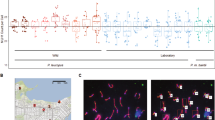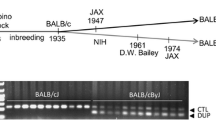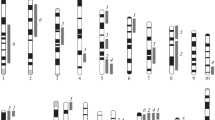Abstract
One of the significant factors that affect brain dopamine function is the activity of tyrosine hydroxylase (TH), the first and rate-limiting enzyme in catecholamine biosynthesis. For the analysis of the genetically determined role of dopamine function and TH in behavior and in the regulatory mechanisms of the mesotelencephalic dopamine system we devised a novel genetic strategy (Vadasz; Mouse Genome 88:16–18; 1990). We hypothesized that phenotypic introgression and recombinant fixation could ensure the transfer of Quantitative Trait Loci (QTL) from one strain onto the genetic background of another strain, and new, genetically very similar quasi-congenic strains could be created that would carry individual QTLs, or QTLs in various combinations. Here we summarize the construction of the first set of QTL Introgression strains, and present evidence that QTLs that are responsible for the continuous variation of mesencephalic tyrosine hydroxylase activity (TH/MES), have been transferred onto the C57BL/6By (B6) strain background from BALB/cJ (C) and CXBI (I) donor strains with high and low TH/MES, respectively. The QTL transfer was carried out in two directions by repeated backcross-intercross cycles with concomitant selection for the extreme high and low expressions of TH/MES in replicates, resulting in four QTL Introgression lines. Analysis of regional brain TH activities in the course of the QTL introgression indicated that (a) TH activity in B6.I lines showed quite limited heritability, (b) TH/MES was not highly correlated with striatal TH, and (c) the control of hypothalamic and olfactory tubercle TH activities was largely independent from that of TH/MES. Examination of the open-field (OF) behavior data demonstrated that TH activity did not correlate significantly with OF behavior. After 5 backcross-intercross cycles, TH/MES in each replicate line was still significantly different from that of the B6 background strain. A genomewide scanning of microsatellite markers in the QTL introgression lines demonstrated that about 96% of the markers were of background (B6) type. These results indicate the successful transfer of TH/MES QTLs. After the QTL transfer phase of the experiment altogether more than 100 new RQI strains were initiated in the QTL Introgression lines by strict brother × sister mating. After fixing the introgressed QTLs, ten of the inbred RQI strains were tested for TH/MES. The results showed that in one of the new RQI strains TH/MES was restored to a level that is characteristic to the C donor strain, while TH/MES values in some other strains were between those of the background and donor strains, confirming our hypothesis that phenotypic introgression and recombinant fixation can ensure a virtually complete transfer of QTLs. We conclude from this study that complex, continuously distributed neural traits can successfully be subjected to QTL introgression, and the results raise the possibility that the RQI method can be efficiently applied for gene mapping of complex neural and behavioral traits even if their phenotypic expression is sensitive to confounding developmental and environmental variations, genetic interactions, and genotype-environment interactions.
Similar content being viewed by others
REFERENCES
Bailey, D. W. 1971. Recombinant-inbred strains. An aid to finding identity, linkage, and function of histocompatibility and other genes. Transplantation 11:325-327.
Baker, H., Joh, T. H., and Reis, D. J. 1980. Genetic control of number of midbrain dopamine-neurons in inbred strains of mice: Relationship to size and neuronal density of striatum. Proc. Natl. Acad. Sci. 77:4369-4373.
Baker, H., Joh, T. H., and Reis, D. J. 1982. Time of appearance during development of differences in nigrostriatal tyrosine hydroxylase activity in two inbred mouse strains. Brain Research 256:157-165.
Baker, H., Joh, T. H., Ruggiero, D. A., and Reis, D. J. 1983. Variations in number of dopamine neurons and tyrosine hydroxylase activity in hypothalamus of two mouse strains. Journal of Neuroscience 3:832-843.
Berrettini, W. H., Ferraro, T. N., Alexander, R. C., Buchberg, A. M., and Vogel, W. H., 1994. quantitative trait loci mapping of three loci controlling morphine preference using inbred mouse strains [see comments]. Nature Genetics 7:54-8.
Buck, K. J., Metten, P., Belknap, J. K., and Crabbe, J. C., 1997. Quantitative trait loci involved in genetic predisposition to acute alcohol withdrawal in mice. Journal of Neuroscience 17:3946-55.
Ciaranello, R. D., Barchas, R., Kessler, S., and Barchas, J. D., 1972. Catecholamines: Strain differences in biosynthetic enzyme activity in mice. Life Sci. 11:565-572.
Coyle, J. T., 1972. Tyrosine hydroxylase in rat brain—cofactor requirements, regional and subcellular distribution. Biochemical Pharmacology 21:1935-1944.
Dains, K., Hitzemann, B., and Hitzemann, R., 1996. Genetics, neuroleptic response and the organization of cholinergic neurons in the mouse striatum. Journal of Pharmacology & Experimental Therapeutics 279:1430-8.
Demant, P., and Hart, A. A., 1986. Recombinant congenic strains—a new tool for analyzing genetic traits determined by more than one gene. Immunogenetics 24:416-422.
Dietrich, W., Katz, H., Lincoln, S. E., Shin, H. S., Friedman, J., Dracopoli, N. C., and Lander, E. S., 1992. A genetic map of the mouse suitable for typing intraspecific crosses. Genetics 131:423-447.
Dukhanina, O. I., Dene, H., Dene, A. Y., Choi, C. R., Hoebee, B., and Rapp, J. P. 1997. Linkage map and congenic strains to localize blood pressure QTL on rat chromosome 10. Mammalian Genome 8:229-35.
Ferraro, T. N., Golden, G. T., Smith, G. G., Schork, N. J., St. Jean, P., Ballas, C., Choi, H., and Berrettini, W. H. 1997. Mapping murine loci for seizure response to kainic acid. Mammalian Genome 8:200-8.
Fleischer, A., and Vadasz, C., Genetic recombination of amphetamine-induced motor behaviors, 24th Annual Meeting of the Society for Neuroscience, Miami Beach, Florida, 1994, pp. Abstr. 420.7.
Frankel, W. N., Valenzuela, A., Lutz, C. M., Johnson, E. W., Dietrich, W. F., and Coffin, J. M., 1995. New seizure frequency QTL and the complex genetics of epilepsy in EL mice. Mammalian Genome 6:830-8.
Galli, J., Li, L. S., Glaser, A., Ostenson, C. G., Jiao, H., Fakhrai-Rad, H., Jacob, H. J., Lander, E. S., and Luthman, H. 1996. Genetic analysis of non-insulin dependent diabetes mellitus in the GK rat [see comments]. Nature Genetics 12:31-7.
Gershenfeld, H. K., Neumann, P. E., Mathis, C., Crawley, J. N., Li, X., and Paul, S. M., 1997. Mapping quantitative trait loci for open-field behavior in mice. Behavior Genetics 27:201-210.
Green, E. L. 1981. Breeding Systems. Page 91-104, in H. L. Foster, J. D. Small, and J. G. Fox (eds.), The mouse in biomedical research, Academic Press, New York.
Green, E. L. 1981. Genetics and probability in animal breeding experiments, MacMillan Publishers Ltd. London and Basingstoke
Harris, H. W. 1996. Immunohistochemical studies of mesolimbic dopaminergic neurons in Fischer 344 and Lewis rats. Brain Research 706:1-12.
Hitzemann, B., Dains, K., Kanes, S., and Hitzemann, R. 1994. Further studies on the relationship between dopamine cell density and haloperidol-induced catalepsy. Journal of Pharmacology & Experimental Therapeutics 271:969-76.
Hitzemann, R., Qian, Y., and Hitzemann, B. 1993. Dopamine and acetylcholine cell density in the neuroleptic responsive (NR) and neuroleptic nonresponsive (NNR) lines of mice. Journal of Pharmacology & Experimental Therapeutics 266:431-8.
Hitzemann, R., Qian, Y., Kanes, S., Dains, K., and Hitzemann, B. 1995. Genetics and the organization of the basal ganglia. International Review of Neurobiology 38:43-94.
Joh, T. H., Geghman, C., and Reis, D. 1973. Immunochemical demonstration of increased accumulation of tyrosine hydroxylase protein in sympathetic ganglia and adrenal medulla elicited by reserpine. Proceedings of the National Academy of Sciences of the United States of America 70:2767-2771.
Kanes, S., Dains, K., Cipp, L., Gatley, J., Hitzemann, B., Rasmussen, E., Sanderson, S., Silverman, M., and Hitzemann, R. 1996. Mapping the genes for haloperidol-induced catalepsy. Journal of Pharmacology & Experimental Therapeutics 277:1016-25.
Kessler, S., Ciaranello, R. D., Shire, J. G. M., and Barchas, J. D. 1971. Genetic variation in catecholamine synthesizing enzyme activities. Genetics 68:s33.
Laurent, C., Savoye, C., Samolyk, D., Meloni, R., Mallet, J., Campion, D., Martinez, M., T. D. A., Bastard, C., and Dollfus, S. 1994. Homozygosity at the dopamine D3 receptor locus is not associated with schizophrenia [letter; comment]. Journal of Medical Genetics 31:260.
Lembertas, A. V., Perusse, L., Chagnon, Y. C., Fisler, J. S., Warden, C. H., Purcell-Huynh, D. A., Dionne, F. T., Gagnon, J., Nadeau, A., Lusis, A. J., and Bouchard, C. 1997. Identification of an obesity quantitative trait locus on mouse chromosome 2 and evidence of linkage to body fat and insulin on the human homologous region 20q. Journal of Clinical Investigation 100:1240-7.
Mallet, J., Meloni, R., and Laurent, C. 1994. Catecholamine metabolism and psychiatric or behavioral disorders. Current Opinion in Genetics & Development 4:419-26.
Markel, P. D., Fulker, D. W., Bennett, B., Corley, R. P., DeFries, J. C., Erwin, V. G., and Johnson, T. E. 1996. Quantitative trait loci for ethanol sensitivity in the LS × SS recombinant inbred strains: interval mapping. Behavior Genetics 26:447-58.
Melo, J. A., Shendure, J., Pociask, K., and Silver, L. M. 1996. Identification of sex-specific quantitative trait loci controlling alcohol preference in C57BL/6 mice [see comments]. Nature Genetics 13:147-53.
Meloni, R., Laurent, C., Campion, D., Ben Hadjali, B., Thibaut, F., Dollfus, S., Petit, M., Samolyk, D., Martinez, M., Poirier, M. F., and et al. 1995. A rare allele of a microsatellite located in the tyrosine hydroxylase gene found in schizophrenic patients. Comptes Rendus de l Academie des Sciences-Serie Iii, Sciences de la Vie 318:803-9.
Meloni, R., Leboyer, M., Bellivier, F., Barbe, B., Samolyk, D., Allilaire, J. F., and Mallet, J. 1995. Association of manic-depressive illness with tyrosine hydroxylase microsatellite marker [letter] [see comments]. Lancet 345:932.
Muthane, U., Ramsay, K. A., Jiang, H., Jackson-Lewis, V., Donaldson, D., Fernando, S., Ferreira, M., and Przedborski, S. 1994. Differences in nigral neuron number and sensitivity to 1-methyl-4-phenyl-1,2,3,6-tetrahydropyridine in C57/bl and CD-1 mice. Experimental Neurology 126:195-204.
Nicolini, H., Sidenberg, D., Camerana, B., Guerra, C., Monteiro Gazira, M., Petronis, A., and Kennedy, J. 1993. Dopaminergic system genes in Mexican schizophrenics. Revista de Investigacion Clinica 45:345-52.
Owen, E. H., Christensen, S.C., Paylor, R., and Wehner, J. M. 1997. Identification of quantitative trait loci involved in contextual and auditory-cued fear conditioning in BXD recombinant inbred strains. Behavioral Neuroscience 111:292-300.
Phillips, T. J., Crabbe, J. C., Metten, P., and Belknap, J. K. 1994. Localization of genes affecting alcohol drinking in mice. Alcoholism, Clinical & Experimental Research 18:931-41.
Reis, D. J., Fink, J. S., and Baker, H. 1983. Genetic control of the number of dopamine neurones in the brain: Relationship to behavior and responses to psychoactive drugs. Page 55-75, in S. S. Kety, L. P. Rowland, R. L. Sidman and S. W. Matthysse (eds.), Genetics of neurological and psychiatric disorders, Raven Press, New York.
Rodriguez, L. A., Plomin, R., Blizard, D. A., Jones, B. C., and McClearn, G. E. 1995. Alcohol acceptance, preference, and sensitivity in mice. II. Quantitative trait loci mapping analysis using BXD recombinant inbred strains. Alcoholism, Clinical & Experimental Research 19:367-73.
Ross, R. A., Judd, A. B., Pickel, V. M., Joh, T. H., and Reis, D. J. 1976. Strain-dependent variations in number of midbrain dopaminergic neurones. Nature 264:654-656.
Segal, D. S., Kuczenski, R. T., and Mandell, A. J. 1972. Strain differences in behavior and brain tyrosine hydroxylase activity. Behav. Biol. 7:75-81.
Snell, G. D. 1948. Methods for the study of histocompatibility genes. J. Genet. 49:87-108.
Snell, G. D., Dausset, J., and Nathenson, S. 1976. Histocompatibility, Academic Press New York
Sziraki, I., Murthy, L. R., Lajtha, A., and Vadasz, C. 1987. Genetic determination of hypothalamic tyrosine hydroxylase activity in mice. Brain Research Bulletin 18:13-18.
Sziraki, I., Sasvari, M., Kabai, P., Kobor, G., Vadasz, I., Lajtha, A., and Vadasz, C. 1988. Strain-dependent variations in kinetic properties of mesencephalic tyrosine hydroxylase. Biogenic Amines 6:177-185.
Thibaut, F., Ribeyre, J. M., Dourmap, N., Meloni, R., Laurent, C., Campion, D., Menard, J. F., Dollfus, S., Mallet, J., and Petit, M. 1997. Association of DNA polymorphism in the first intron of the tyrosine hydroxylase gene with disturbances of the catecholaminergic system in schizophrenia. Schizophrenia Research 23:259-64.
Vadasz, C. 1990. Development of congenic recombinant inbred neurological animal model lines. Mouse Genome 88:16-18.
Vadasz, C., Laszlovszky, I., and Fleischer, A. 1994. Dopamine system-specific QTL introgressed lines: Response to cocaine. Mouse Genome 92:699-701.
Vadasz, C., Baker, H., Fink, S. J., and Reis, D. J. 1985. Genetic effects and sexual dimorphism in tyrosine hydroxylase activity in two mouse strains and their reciprocal F1 hybrids. Journal of Neurogenetics 2:219-230.
Vadasz, C., Baker, H., Joh, T. H., Lajtha, A., and Reis, D. J. 1982. The inheritance and genetic correlation of tyrosine hydroxylase activities in the substantia nigra and corpus striatum in the C × B recombinant inbred mouse strains. Brain Research 234:1-9.
Vadasz, C., Kobor, G., Kabai, P., Sziraki, I., Vadasz, I., and Lajtha, A. 1988. Perinatal anti-androgen treatment and genotype affect the mesotelencephalic dopamine system and behavior in mice. Hormones & Behavior 22:528-539.
Vadasz, C., Kobor, G., and Lajtha, A. 1982. Neuro-Behavioral Genetic Analysis in Recombinant Inbred Strains. Page 127-154, in I. Lieblich (ed.), Genetics of the Brain, Elsevier Biomedical Press, Amsterdam.
Vadasz, C., Kobor, G., and Lajtha, A. 1992. Motor activity and the mesotelencephalic dopamine function. I. High-resolution temporal and genetic analysis of open-field behavior. Behavioral Brain Research 48:29-39.
Vadasz, C., Kobor, G., and Lajtha, A. 1992. Motor activity and the mesotelencephalic dopamine function. II. Multivariate analysis of genetically segregating generations. Behavioral Brain Research 48:41-47.
Vadasz, C., Sziraki, I., Murthy, L. R., Badalamenti, A. F., and Lajtha, A. 1987. Genetic determination of mesencephalic tyrosine hydroxylase activity in the mouse. Journal of Neurogenetics 4:241-252.
Vadasz, C., Sziraki, I., Murthy, L. R., Sasvari-Szekely, M., Kabai, P., Laszlovszky, I., Fleischer, A., Juhasz, B., and Zahorchak, R. 1994. Transfer of brain dopamine system-specific quantitative trait loci onto a C57BL/6ByJ background. Mammalian Genome 5:735-7.
Vadasz, C., Sziraki, I., Sasvari, M., Kabai, P., Laszlovszky, I., Juhasz, B., and Zahorchak, R. 1996. Genomic characterization of two introgression strains (B6.Cb4i5) for the analysis of QTLs. Mammalian Genome 7:545-8.
Williams, R. W., Storm, R. C., and Goldowitz, D. 1998. Natural variation in neuron number in mice is linked to a major quantitative trait locus on Chr 11. The Journal of Neuroscience 18:138-146.
Author information
Authors and Affiliations
Rights and permissions
About this article
Cite this article
Vadasz, C., Sziraki, I., Sasvari, M. et al. Analysis of the Mesotelencephalic Dopamine System by Quantitative-Trait Locus Introgression. Neurochem Res 23, 1337–1354 (1998). https://doi.org/10.1023/A:1020790320875
Issue Date:
DOI: https://doi.org/10.1023/A:1020790320875




